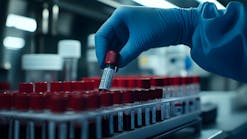Urinalysis is an
invaluable tool for diagnosing urologic conditions, and it currently
accounts for one-third of all lab specimens. Urine testing, already
prevalent in the clinical lab, is becoming a growing area of focus in
microbiology labs as well. Technicians are always striving to improve
efficiency within departments of the laboratory. Recently,
microbiologists have been seeking methods to screen out unnecessary
cultures and provide faster turnaround times. Urinalysis is critical in
detecting urinary-tract infections (UTIs), which are one of the most
common infectious diseases and which pose a substantial financial burden
to the healthcare system. According to the National Kidney Foundation,
UTIs account for 7 million physician visits per year, approximately 15%
of all community prescribed antibiotics, and an annual cost of more than
$1 billion.
Historically, urine-screening techniques have
involved tedious manual steps which are time consuming for laboratories
often already short-staffed and pressed for time. laboratory technicians
have noted that the rapid report of a negative result is critical to
improving patient care and eliminating the need for additional lab work.
With a growing demand for urinalysis in microbiology, it is no wonder
that the industry is shifting toward automated urinalysis.
Preanalytical phase and testing
Current urinary-screening methods — mainly based
on microscope cell numeration — are still manual, time consuming, and a
common source for errors. Although half of urine screenings are still
performed with a microscope, we are witnessing a paradigm shift as more
labs begin to move from manual methods to modern automated urine
systems. The adoption of rapid, automated instruments allows technicians
to accurately screen for the presence of bacteria in approximately two
minutes. Lab technicians can identify specimens, which may need no
further screening and prioritize their efforts toward determining the
source of an infection in positive test results. This streamlined
workflow not only speeds results but also may protect patients from
unnecessary tests and, potentially, lower lab costs for both patients
and healthcare institutions.
The standard process for laboratory testing of
urine includes specimen collection and macroscopic examination, followed
by test-strip examination and microscopic examination. It is during the
close examination of solid particles and cells that we can determine if
there are bacteria present. If so, labs then move on to culturing the
specimen for identification and susceptibility testing. This process can
take 24 to 48 hours to obtain results. Given that approximately 70% of
specimens are negative upon culture, however, the need to rapidly
eliminate the volume of unnecessary testing is quite apparent.
Evolution to rapid testing — automation in action
The first automated urine cell analyzer,
developed in 1995, transformed urinalysis from a time-consuming and
labor-intensive process to an unattended one. Since that time,
additional automated cell analyzers have been introduced to perform
routine formed-element analysis in urine. In 2007, a new generation of
particle analysis providing highly precise measurements for white blood
cells, red blood cells, epithelial cells, casts, and bacteria was
developed. This advance resulted in improved sensitivity for
pathological elements and enhanced standardized analysis information for
the screening of patients with kidney disease and other infections.
This new urinalysis system is built upon the same
fluorescent flow-cytometry technology of the first analyzers. Cytometry
measures the physical and chemical characteristics of cells, and flow-cytometry
measurements are made while cells pass single file in a sheath-like
laminar flow. Cellular characteristics detected include size,
granularity, and biochemical structure inside and on the surface of the
cells. The properties of the light scatter identify cell populations of
interest, while fluorescent information provides distinct information to
individual cells. In general, today’s automated urinalysis solutions
have a smaller footprint, use less power, and have improved detection
for bacteria with a separate analysis channel, resulting in more
accurate detection and quantification of bacteria.
Given that approximately 70% of specimens are negative upon
culture, however, the need to rapidly eliminate the volume of
unnecessary testing is quite apparent.
Results are provided in clear-cut numeric values,
and supported by easy-to-read, color-coded scatter-grams for concise
overview. Positive results are flagged at user definable concentrations,
to facilitate the rapid reporting of results. In addition to accurate
detection and enumeration of urine particles, these systems provide
several operational benefits, such as a bar-code reader for rapid
identification of samples and reagents, as well as quality-control
material designed to monitor all the main parameters. Some automated
systems also help reduce the risk of cross-contamination with
anti-carryover functions and sequential-analysis modes.
For the user, automated urinalysis provides true
walkaway operation. They require minimal hands-on time and maximize
efficiency. Not long ago, it took a technician an average of six minutes
per specimen to perform a urine microscopy. Now, the entire test can be
completed in a matter of seconds and lab professionals can feel
confident that they are producing accurate, standardized results.
The LEAN Lab
Automated urinalysis screening allows labs to
become LEAN. Operating in a highly regulated manufacturing environment,
healthcare companies look for resources to save time and money. In
recent years, there has been a push to adopt a LEAN approach to rapid
identification and testing to increase efficiencies. As part of this
drive toward adopting LEAN practices, automated urinalysis allows
clinical labs to begin implementing a LEAN laboratory concept, similarly
used in manufacturing and testing of products.
As part of this drive toward adopting LEAN practices,
automated urinalysis allows clinical labs to begin implementing a
LEAN laboratory concept, similarly used in manufacturing and testing
of products.
Only in recent years have microbiology
laboratories integrated a LEAN-lab approach. Due to the low volume of
samples but high degree of variability and complexity, microbiology labs
have been last to adopt such procedures. Careful adaptation of automated
urinalysis screening delivers significant benefits in terms of cost and
speed, and allows LEAN labs to rapidly identify positive and negative
cultures, reducing the number of tests further down the line and
providing the best care possible to the patient.
As additional advances are made to the
often-overlooked urinalysis preanalytical function, it is anticipated
that even more time will be saved in the lab. By eliminating the need
for costly and unneeded tests, labs are able to be more efficient and
streamline their daily operations. All of this helps make a LEAN lab an
attainable aspiration and is proof of yet one more reason why lab
automation is a win-win solution for everyone involved.
Mike Cronin is bioM’erieux U.S.’s clinical
marketing manager for the distribution of the Sysmex UF-1000i system. To
learn more please visit
www.biomerieux-usa.com. The first fully
automated urine-particle analyzer, the UF-100, was developed and
manufactured by Sysmex Corp., Kobe, Japan. The UF-1000i analyzer, also
manufactured by Sysmex, is distributed globally by bioM’erieux for
microbiology laboratories.
For related product information click here..





